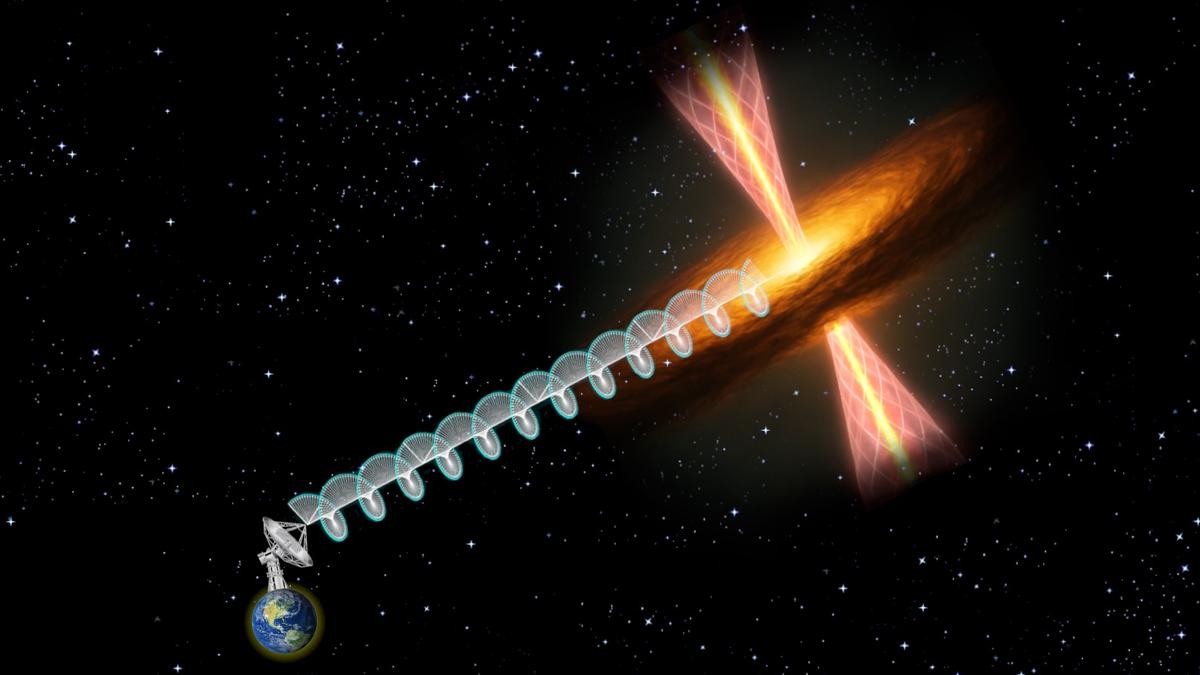An artist’s impression of the emissions from the protostar. The circular polarisation is shown in the schematic image as a twisted light beam.
| Photo Credit: Special Arrangement
An international team led by astronomers from the Indian Institute of Space Science and Technology (IIST) here has discovered radio emission with a special property known as circular polarisation near a massive young protostar that is still forming about 4,500 light years from earth. [Protostar refers to the earliest known stage of a star when it is still accumulating gas and dust material from its surroundings.]
The discovery linked to IRAS 18162-2048, a massive protostar in the Milky Way galaxy, opens an exciting window into scientists’ understanding of how massive stars form, astronomers at the IIST said on Thursday.
Circular polarisation occurs when electric and magnetic field vectors of electromagnetic waves—in this case radio waves—rotate in a circle about the direction in which the waves travel through space. This emission offers the first direct clue to the strength of magnetic fields in the immediate neighbourhood of a protostar, they said.
The findings have been published in The Astrophysical Journal Letters under the title ‘First Detection of Circular Polarization in Radio Continuum Toward a Massive Protostar.’
In the early stage, the protostar can also eject high-velocity material in opposite directions, known as a bipolar jet. ‘Massive protostars’ evolve to have mass more than 8 to 10 times that of the Sun.
Protostellar jets
According to the astronomers, IRAS 18162-2048 powers one of the largest and brightest known protostellar jets in the Milky Way, the HH80-81 jet. It is believed that the magnetic field and rotation in the protostellar system are responsible for the ejection of the jet. While a magnetic field has been imaged from the jet earlier, this is the first time that hints of it have been detected directly from this massive protostar, according to the IIST.
Strong magnetic fields have been observed earlier in low-mass protostars that go on to form stars like the Sun. But measuring such fields around massive protostars has remained elusive, until now.
Much harder to study
“Massive protostars are much harder to study. The circular polarisation we are looking for is very faint and sporadic, making such measurements very challenging,” Amal George Cheriyan from the IIST, lead author of the paper, said in a statement.
The radio observations were carried out using the National Radio Astronomy Observatory’s (NRAO) Karl G. Jansky Very Large Array (VLA) in the U.S.
“This is the first inference of the magnetic field strength using circular polarisation in radio waves from a massive protostar,” said Sarita Vig of the IIST who conceptualised the work.
Remarkable result
“The detection of circular polarisation is an exceptionally rare and challenging feat even in active galactic nuclei (AGNs), where conditions are extreme, but better investigated,” Nirupam Roy from the Indian Institute of Science (IISc), Bengaluru, said. Samir Mandal of the IIST noted that observing the phenomenon in the environment of a massive protostar, which lies buried in dense gas and dust, is even more difficult, making this result remarkable.
The new data has allowed researchers to infer that the magnetic field near the protostar is roughly 100 times stronger than the Earth’s magnetic field. They also support a long-standing theory that powerful jets from stars and black holes are driven by the same magnetic engine.
Published – July 17, 2025 05:51 pm IST
